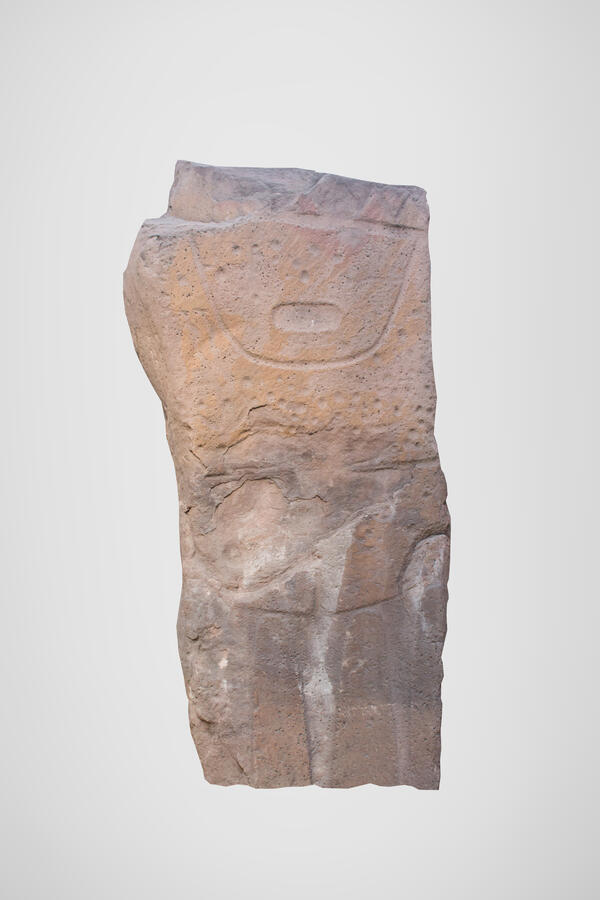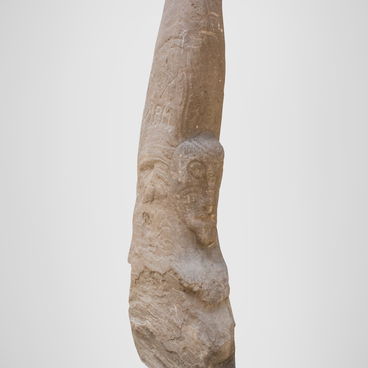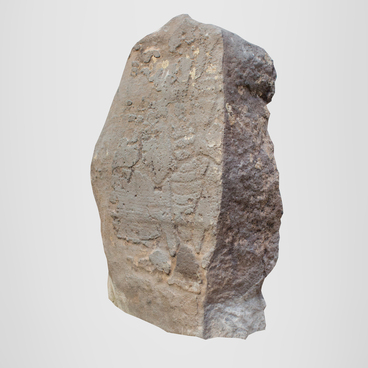A stone statue with mirrored faces was found by archaeologists in the lower reaches of the Tyoya River in the Askiz region of the Republic of Khakassia. The stela was installed in the corner of the fence of the Tagar culture mound on the right bank of the river, at its mouth.
The statue was carved out of red sandstone and is approximately 2.5 meters high. The edges of the slab are broken off. Fragmented images of two humanoid masks are engraved on it. In one of them, only the lower part with an elongated oval mouth and a transverse ornamental belt of triangles has survived to this day. Below the belt, you can see traces of the embossed horizontal line separating the lower part. This mask, according to the assumptions of historians, was engraved first. Above and below it, hemispherical holes are carved — signs and symbols of sacrifices.
In the summer, on a full moon, the Khakass performed the so-called heavenly sacrifice on the sacred mountains. It was attended by men, children and adolescents, shamans and married women were not allowed to the ceremony. The head of the community supervised the ritual. The heavenly sacrifice consisted of the ritual of offering mare’s milk, the ritual of sacrificing the victim and treating the heavenly powers with steam of boiled meat. After worshiping the Great Heaven, they began to eat, played musical instruments, arranged games and competitions.
The other face, on the contrary, has the upper part, with the left eye and three rays. It was carved into the stone only later, after a large fragment of the slab with the image of the first mask peeled off. The stone was turned over, and the new mask was mirrored in relation to the first. The mouth and lower part of the first, earlier face served as details of the new image. This assumption is confirmed by other known cases of reused statues made in the same era, which have two faces at both ends of the stelae.
The upper, “eye” part of the second face is separated by a horizontal line. It has eyes in the form of circles with dots and a head part with the image of three rays gradually tapering upward. In the upper part, right on the forehead of the mask, there are two figures — a bull and a man. In addition, another image of the animal was carved on the stela, but archeologists have not been able to find out what kind of animal it is.
The statue was carved out of red sandstone and is approximately 2.5 meters high. The edges of the slab are broken off. Fragmented images of two humanoid masks are engraved on it. In one of them, only the lower part with an elongated oval mouth and a transverse ornamental belt of triangles has survived to this day. Below the belt, you can see traces of the embossed horizontal line separating the lower part. This mask, according to the assumptions of historians, was engraved first. Above and below it, hemispherical holes are carved — signs and symbols of sacrifices.
In the summer, on a full moon, the Khakass performed the so-called heavenly sacrifice on the sacred mountains. It was attended by men, children and adolescents, shamans and married women were not allowed to the ceremony. The head of the community supervised the ritual. The heavenly sacrifice consisted of the ritual of offering mare’s milk, the ritual of sacrificing the victim and treating the heavenly powers with steam of boiled meat. After worshiping the Great Heaven, they began to eat, played musical instruments, arranged games and competitions.
The other face, on the contrary, has the upper part, with the left eye and three rays. It was carved into the stone only later, after a large fragment of the slab with the image of the first mask peeled off. The stone was turned over, and the new mask was mirrored in relation to the first. The mouth and lower part of the first, earlier face served as details of the new image. This assumption is confirmed by other known cases of reused statues made in the same era, which have two faces at both ends of the stelae.
The upper, “eye” part of the second face is separated by a horizontal line. It has eyes in the form of circles with dots and a head part with the image of three rays gradually tapering upward. In the upper part, right on the forehead of the mask, there are two figures — a bull and a man. In addition, another image of the animal was carved on the stela, but archeologists have not been able to find out what kind of animal it is.



